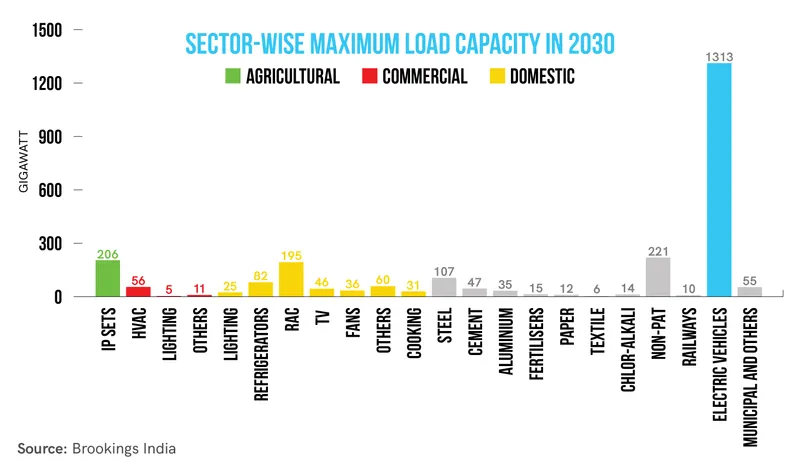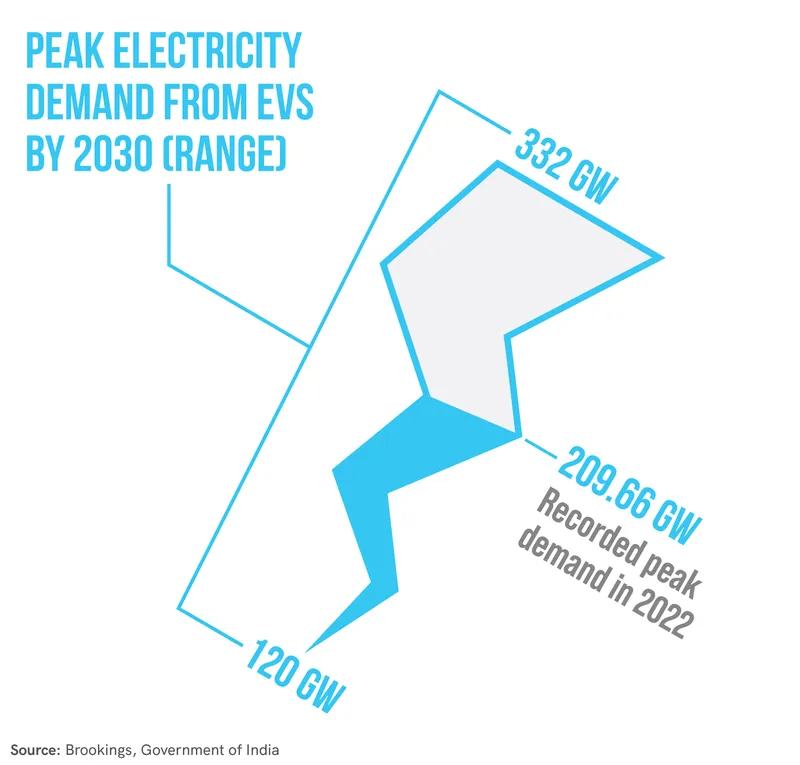Can India’s power grid support its EV ambitions?
As the number of electric vehicles on the road goes up, concerns mount about their load on India’s already strained power grid. Potential solutions include smart charging, efficient batteries, and interconnectivity between grids—but will these be enough to mitigate the stress?
Key Takeaways
- Around 1.17 million EVs were sold in FY 2022-23, making up over 50% of the 2.27 million EVs on Indian roads.
- EVs are expected to draw 120 GW to 332 GW by 2030, accounting for the majority of the load on India’s power grid.
- Efficient batteries, vehicle-to-grid technology, time-of-day charging, etc., can help alleviate the load of EVs on the grid.
India’s ambitious plan to accelerate electric vehicle (EV) adoption is well-intentioned and executed, but there’s an important question that demands attention—can the country’s power grid handle the massive surge in demand?
At present, EVs form only a small percentage—around 1%—of the total number of vehicles on road. But the numbers are growing fast.
In FY 2022-23, 1.17 million EVs were sold across categories, accounting for more than half of the cumulative 2.27 million EVs on road in India, according to data released by the government’s Vahan database.
The EV boom in India is relatively new, mostly led by sales of two- and three-wheelers from big homegrown brands such as , , and Mahindra Piaggio. Four-wheeler-led personal mobility is still catching up as more and more brands focus on electric cars.
For now, the situation seems to be under control. The power grid is more than able to support the charging of EVs given they're still just a fraction of the total 362 million vehicles on road in India, according to a Statista report for FY22.
However, the situation will likely change over the next seven years, warn several researchers, including government think-tank .

By 2030, the majority of the load on India’s power grid is expected to come from EVs—higher than even steel and other industries, according to a Brookings report.
In fact, the Washington-based public policy organisation estimates that peak contribution—the maximum electricity that EVs could demand from the energy grid—could be anywhere between 120 gigawatt and 332 GW by 2030.
The upper end of that range is significantly higher than the recorded peak power demand of 209.66 GW in 2022—signalling the need to enhance the capacity of the power grid, and increase not just electricity generation, but also distribution.

Generation and distribution
In FY22, India’s overall power generation, including from renewable sources, increased by 7.96%, as per the Ministry of Power. In FY23, till February this year, it increased by 9.25% to 412.21 GW.
Brookings estimates that if the government stays on target of 100% of new automobile sales being EVs by 2030, the electricity demand would be around 100 terawatt (1 TW equals 1,000 GW).
In Brookings' 'realistic' scenario, even if 33% of total auto sales by 2030 are EVs, the electricity demand would be around 37 TW.
Considering the national electric grid in India had an installed generation capacity of 412.21 GW as on February 28, 2023, it’s easy to see why there’s growing scepticism around the country’s grid being able to support electricity demand from EVs and EV infrastructure.
More than generating electricity though, much work also needs to be done on the distribution level, according to NITI Aayog’s ‘Handbook of EV charging infrastructure implementation' released in 2021.
"With growing EV adoption, increased charging loads pose risks at multiple levels, from the DISCOM’s service area to the feeder level," the think-tank noted.
It added that while smart technologies can be employed to manage charging loads, distribution companies need to urgently put into place plans for grid upgrades and network expansion.

Sudhir Kumar, Director of Infrastructure Ratings at Credit Analysis and Research, concurs that any bottlenecks in distribution need to be eased out.
“Distribution of electricity will need to catch up, and it’ll be up to power distribution companies to create the necessary infrastructure. It has to make economic sense for them since it’ll also need a lot of capex expansion,” he tells YourStory.
Potential solutions
There are several ways to alleviate the load of EVs on the power grid:
Using better batteries
Efficient batteries, such as solid-state, lithium-ion, nickel-metal hydride, and sodium-ion batteries, have a higher energy density and are capable of storing more energy compared to traditional batteries.
EVs equipped with these batteries can travel further on a single charge and don’t need to be charged as frequently, reducing the load on the power grid. Moreover, efficient batteries also charge faster, thus reducing the charging time.
Mandatory battery replacements
Introducing legislation that regulates the lifespan of batteries used in EVs can encourage users to replace existing batteries with newer, more efficient ones. Such new energy-dense batteries don’t require frequent charging.
Using vehicle-to-grid technology
Vehicle-to-grid (V2G) technology allows EVs to not only draw power from the grid but also feed electricity back into it when not in use. This two-way charging system has the potential to help balance the grid's supply and demand, stabilise its frequency, and even provide a backup power source during outages.
Users who put electricity back into the grid can be rewarded with discounts on their next charge or offered cashback.
Time-of-use charging
Time-of-day charging, also known as time-of-use (TOU) charging, is a pricing strategy that incentivises EV owners to charge their vehicles during off-peak hours when electricity demand is lower. Incentives can range from lower electricity rates to discounts on further charges.
Time-of-day charging can be beneficial for both EV owners and the power grid as a whole. For EV owners, it can help to reduce the cost of charging their vehicles and make EV ownership more affordable. It can also aid the power grid in balancing the supply and demand of electricity, especially during peak hours.
Smart charging
Smart charging can prevent grid overload by regulating the amount of electricity being drawn during peak periods and adjusting the charging rate so that the grid remains stable.
In some newer technologies, smart charging can be optimised to take advantage of renewable energy sources, such as wind and solar power. By charging EVs during periods of high renewable energy production, smart charging can help reduce the reliance on fossil fuels for charging.

“Pilot projects in different parts of the world have demonstrated that smart charging in coordination with passive management measures is effective in shifting a substantial share of the EV charging load to off-peak times, while still satisfying customers’ charging needs,” said a NITI Aayog report.
Interconnectivity between grids
Interconnectivity between grids can balance demand and supply by transferring excess electricity to where there is excess demand.
For example, if one region has an abundance of renewable energy, such as wind or solar power, it can export that excess electricity to other regions where the demand is higher.
Connected electricity grids can also improve the reliability and resilience of the power distribution system by providing backup power in the event of an outage or emergency.
Expanding the country’s power grid is a very capital-intensive undertaking since it would require setting up numerous new transformers, generators, and transmission lines. However, this need is justified to fully accommodate the growth of electric vehicles.
Plans are already underway to expand the country’s power generation and transmission capacity. Last year, the government announced a Rs 2.44 lakh crore plan to increase electricity production from renewable sources by 2030, as well as adding over 10,000 circuit kilometres of transmission lines for some of these projects.
The project aims to increase the country’s electricity generation capacity, specifically from non-fossil fuel sources, to a whopping 500 GW from 409 GW. By 2030, it is projected that renewable sources will account for approximately 65% of India's overall power generation.
Increased economic activity along with EV adoption requires a meticulous evaluation of the power grid’s capacity.
It’s a problem that will require significant investment of resources and careful planning. However, the benefits of transitioning to a clean and sustainable energy system are clear, and with the right investments, policies, and tech adoption, India’s power grid can be strengthened to enable the future of transportation.
(Feature image and graphics by Nihar Apte.)
Edited by Kanishk Singh











